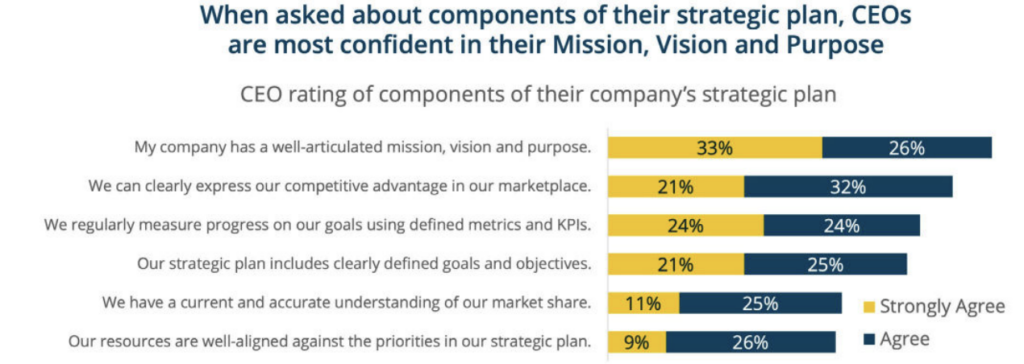Have you recently asked your marketing team or agency to provide the latest insights and recommendations on AI? We don’t blame you. There’s a lot of excitement around these new tools and technologies. But when was the last time you reassessed your organization’s strategic plans? We often work with clients caught up in the latest marketing trends without a clear Why behind their initiatives. If your leadership team is frequently unsatisfied with marketing performance, this could be the canary in the coal mine for a much broader issue. Read on to learn how to avoid the costly impacts of bad marketing with proactive and dynamic strategic planning.
Why Strategic Planning Still Matters
According to Shopify, fewer than two-thirds of the businesses that started in 2018 remained in operation three years on. Yahoo Finance recently published an article that predicts nearly 30,000 companies will fail in 2024, the highest level of corporate insolvencies since 2004.

A few reasons for high business failure rates are external macro factors, from interest rates to AI, which are more volatile than ever, and internal factors, including poor business planning and market awareness. A recent report by Vistage highlighted an executive leadership confidence gap between a well-defined purpose and organizational progress toward strategic outcomes. Beyond setting aligned mission and vision statements for their strategic plans, organizations fail to measure OKRs regularly, understand current market share, and align resources with priorities—all essential to tracking progress toward strategic outcomes.

Types of Strategic Planning
Rigid Strategic Planning
Rigid strategic planning is a robust process to align an organization with a long-term mission, vision, goals, and action plan. The cost of these projects tends to range from $20,000 to $100k+ and can last several years. So, it makes sense why organizations fall behind on their strategic plans with this framework, as they’re performed once every five to ten years. These long-term and expensive planning processes ultimately lead organizational stakeholders to become caught in a continuous cycle of reactive, short-term deliverables versus meaningful outcomes, snowballing into other company areas, like marketing.
What’s happened is that executives ask for long-term strategic perspectives, but in reality they are limiting their teams to narrow timeframes, resulting in a perpetual review of the same objectives with only minor adjustments. Here’s a sobering truth that most C-suites won’t acknowledge: Considering the speed at which most modern companies are reasonably capable of moving (read: laboriously slow compared to the rate of external change), by the time a two-year plan is executed the future will have moved further out of reach. Strategy’s mission-critical responsibility — to chart a clear organizational direction and follow through with a robust execution plan — is being overridden by the immediate pressures of resource allocation and everyday operational tactics.
Bringing True Strategic Foresight Back to Business, Harvard Business Review
Nimble Strategic Planning
Nimble strategic planning is a dynamic and flexible approach to developing and implementing annual and quarterly strategic initiatives. It emphasizes agility, adaptability, and responsiveness to changing circumstances in the business environment. Unlike a rigid framework, nimble strategic planning focuses on shorter-term objectives and iterative processes that allow quick adjustments and course corrections.
In today’s world, strategic planning must be nimble. When the next growth cycle starts, leaders need to be able to accelerate on a dime. Similarly, they must be adaptable to emerging technology. And they are required to understand the unpredictable nature of the current macroeconomic landscape. Similarly, strategic plans must evolve in scope and scale over time.
Why CEOs Need to Rethink Strategy in 2024, INC
Key characteristics of nimble strategic planning include:
- Agility: Nimble strategic planning emphasizes the ability to respond quickly and effectively to changes in the market, technology, competition, regulations, or other external factors that may impact the organization.
- Flexibility: Plans and strategies are designed to be flexible and adaptable, allowing for adjustments based on real-time feedback and evolving circumstances.
- Decentralization: Decision-making authority is often decentralized, empowering employees at all levels of the organization to make decisions that support strategic objectives. This enables faster responses to changing conditions and promotes innovation and creativity.
- Continuous Improvement: Nimble strategic planning involves regular review and iteration of plans and strategies to assess progress, gather feedback, and identify opportunities for improvement. It embraces a learning mindset, treating failures as learning experiences and opportunities for growth.
- Collaboration and Communication: Effective collaboration and communication are essential components of nimble strategic planning. It involves open channels of communication between different departments, levels of management, and stakeholders to ensure alignment and integration of efforts towards common goals.
Overall, nimble strategic planning enables organizations to navigate uncertainty and complexity more effectively, seize opportunities as they arise, and stay competitive in a rapidly changing business landscape.
How to Launch Your Next Nimble Strategic Plan
Organizations can’t afford to bypass strategic planning. They also likely can’t afford to spend thousands of dollars and hundreds of hours on intensive strategy initiatives to build 3-, 5-, and even 10-year plans that will be outdated next year. A nimble strategic planning framework balances the need for a foundational North Star with the agility to navigate emerging and fast-moving environments. Here are three actionable steps to help your organization get started with your next nimble strategic plan.
- Flexible Goal Setting and Decision Making
- Set flexible and adaptable goals that align with the organization’s vision and mission. Instead of rigid, long-term plans, focus on shorter-term OKRs aligned across departments that can be adjusted as needed.
- Encourage decentralized decision-making and empower employees at all levels to make decisions that support OKRs. This will allow for quicker responses to changes in the business environment and promote innovation and creativity.
- Continuous Environmental Scanning
- Outline a clear cadence for teams to perform SWOTs (Strengths, Weaknesses, Opportunities, Threats) to assess positioning shifts and identify areas for improvement. This includes analyzing market trends, competitor actions, technological advancements, regulatory changes, and customer preferences. For example, your marketing teams should own the continual monitoring of consumer behaviors and AI impacts across marketing channels.
- Foster a culture of curiosity and information-sharing across teams to ensure that insights from various departments and levels are elevated quickly.
- Regular Review and Iteration
- Implement agile methodologies, such as Scrum or Kanban, to facilitate iterative execution, enabling the organization to respond swiftly to evolving circumstances.
- Establish regular review cycles to assess progress towards OKRs and evaluate the effectiveness of implemented tactics. This includes gathering feedback from stakeholders and adjusting plans accordingly.
- Embrace a learning mindset within the organization, treating failures and setbacks as opportunities for growth and improvement. Encourage experimentation and innovation, and be willing to pivot or change course when necessary.
By following these steps, your organization can develop an agile strategic planning approach that enables your teams to set clear success outcomes and maintain a competitive edge by proactively adapting versus reacting.
Connect with us on LinkedIn to continue the conversation.

